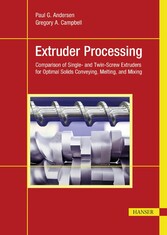
Paul G. Andersen, Gregory A. Campbell
Extruder Processing
Comparison of Single- and Twin-Screw Extruders for Optimal Solids Conveying, Melting, and Mixing
Single-screw or twin-screw extruder? When the need to produce a homogeneous polymer melt occurs in the industrial environment, both product attributes and equipment cost must be evaluated. For many applications both the single and twin-screw extruder will produce the desired homogeneous melt needed to form the product through an extrusion die. Some applications such as dispersive mixing of solids in a polymer matrix are best accomplished in a twin-screw extruder. On the other hand, applications involving chemical reactions, color concentrate distributive mixing, and in line polymer-polymer distributive mixing can be accomplished with either device.
However, for the same production rate, twin-screw extruders are generally more expensive than single-screw extruders with a diameter less than 200 mm. Therefore, a thorough understanding is needed for the concepts of solids conveying, melting, and mixing for the two types of extruders to make appropriate process acquisition decisions. This book covers engineering and technology concepts that should aid the practitioner in comparing these two types of extrusion equipment relative to process requirements.
Paul G. Andersen, Ph.D., is Process Technology Consultant at Coperion Corporation, Ramsey, NJ, USA. He was previously Director, Process Technology at Coperion, a position he held until 2016. In 2009/2010, he was President of the Society of Plastics Engineers (SPE).
© 2009-2024 ciando GmbH
 Zu Hanser-Fachbuch.de
Zu Hanser-Fachbuch.de
 Warenkorb
Warenkorb